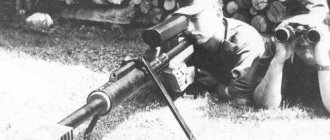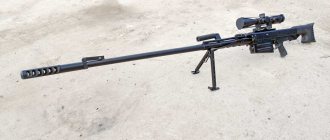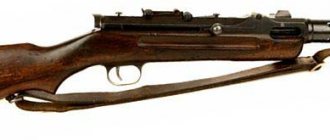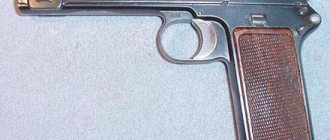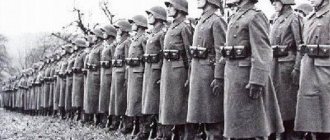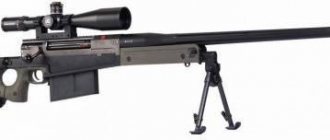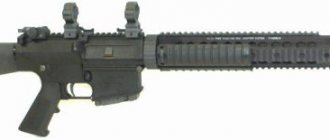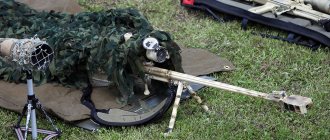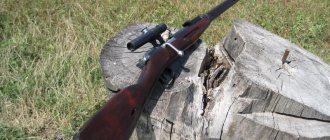Steyr Mannlicher M1895/M1895/30 rifle
| Steyr Mannlicher M1895 rifle |
By the early 1890s, the Austro-Hungarian army was armed with repeating rifles and carbines designed by the Austrian gunsmith Ferdinand Ritter Von Mannlicher, who worked at a weapons factory in the city of Steyr.
The first rifle of his design, the Steyr Mannlicher M1886, was adopted by Austria-Hungary in 1886, followed by the Steyr Mannlicher M1888 in 1888. And in 1890, the Steyr Mannlicher M1890 carbine was developed with an improved bolt and magazine. Mannlicher's rifles and carbines used a direct-action longitudinally sliding bolt that opened and closed without turning the handle, as well as a central magazine with a stack clip.
| Rifle | Carabiner/Fitting | |||
| M1895 | M1895/30 | M1895 | M1895/30 | |
| Caliber, mm | 8×50R | 8×56R | 8×50R | 8×56R |
| Length, mm | 1272 | 1003 | ||
| Barrel length, mm | 765 | 500 | ||
| Weight without cartridges, kg | 3.78 | 3.36 | ||
| Store, count. cartridges | 5 | 5 | ||
| Initial bullet speed, m/s | 625 | 810 | 545 | 720 |
| Sighting range, m | 1950 | 2200 | 1800 | 2000 |
By 1895, the design of this weapon was finally formed and a new infantry repeating rifle with manual reloading, the Steyr Mannlicher M1895, also known as the Infanterie Repetier-Gewehr M1895, was adopted into service by Austria-Hungary.
The new Mannlicher rifle of the 1895 model was designed, like the 1888 model, chambered for an 8 mm caliber cartridge, but had a number of significant differences.
The Model 1895 bolt was also direct action, but much more advanced than the 1888 model and is a development of the more advanced bolt developed for the Model 1890 carbine. The bolt and receiver have become shorter than in the 1888 model, and the locking is stronger - on two protrusions of the combat cylinder, which are located in the vertical plane and near the cartridge head. The magazine of the new rifle, like the M1890 carbine, used a new cartridge feeder, which led to a reduction in the size and weight of the magazine, and the magazine itself was placed closer to the trigger guard, making them fused.
| Mannlicher system model 1895 |
In addition, the new rifle received a barrel guard that covers almost the entire barrel, and lost the ring at the rear sight holding the fore-end together. The front fastening ring for the fore-end was slightly shifted back, and the mount for the bayonet and a special crutch located on it, designed for coupling rifles when stacking them into sawhorses, were swapped (the mount for the bayonet was placed at the bottom, and the crutch was on the left). The sector sight was replaced by a more advanced frame sight.
View of the bolt and magazine Steyr Mannlicher M1895
From a technical point of view, the Steyr Mannlicher M1895 refers to magazine rifles with manual reloading with a direct-action sliding bolt without rotation when locking.
The direct action bolt has a cylindrical body with two longitudinal guides, into which the bolt head shank is inserted in front, on which the lugs are made. On the inside of the bolt body there are spiral protrusions that fit into reciprocal grooves on the shank of the bolt head, which convert the longitudinal movement of the bolt body into rotation of the bolt head with lugs for locking and unlocking the bolt.
In order to separate the bolt from the rifle, the trigger must be pulled forward. When moving it backwards, the shutter can be easily removed.
View of the bolt and sight of the Steyr Mannlicher M1895.
Trigger-type trigger mechanism. The hammer protrudes from the bolt at the tail, allowing it to be manually cocked without opening the bolt.
The non-automatic safety lever is located on the left side behind the receiver. When raised up, it engages the bolt and locks it and pulls the firing pin back slightly. When the flag is lowered down to the left, the rifle is transferred to the “fire” position.
The rifle is fed with ammunition from an integral box-shaped single-row magazine with a capacity of five rounds. The magazine is loaded using a pack-type clip, pre-loaded with cartridges, which is inserted into the magazine from above. When all the cartridges are used up, the empty pack falls out under its own weight through a special window in the bottom of the magazine.
View of the magazine (bottom) Steyr Mannlicher M1895
Pack-type clip, single-sided, made of thin steel. The cartridges in the clip are arranged so that the head of each upper cartridge is in front of the head of the lower cartridge, which ensures trouble-free pushing of them into the barrel by the bolt. The clip-pack has an oblique shape and is inserted into the magazine on one side. A distinctive feature of the pack is the presence of a “top” and a “bottom”, determined by the use of cartridges with a welt (protruding edge). The “top” part of the pack is corrugated. The pack, which still contains cartridges, can be removed through the open bolt after pressing the pack lock located in front of the trigger guard.
The barrel on the outer surface is a body of rotation; its cross section is variable, decreasing towards the muzzle. In the rear part there is a thread, onto which the receiver is screwed with an interference fit. The rifled part of the barrel has four grooves, curling from left to top to right.
View of the barrel with an attached bayonet.
The receiver has a channel along the entire length for placing the bolt with longitudinal grooves in the horizontal plane for the lugs, ending in the front with a thread for connecting to the barrel and an annular groove for placing the lugs when the barrel channel is locked. The rear bridge is made primarily to stiffen the receiver.
The sight is frame, consists of a sighting block, which is integral with a tubular base mounted on the barrel and tin soldered to it, a sighting frame, an axis of the sighting frame, a spring of the sighting frame, a movable clamp with a latch. To hold the sighting frame in the vertical and horizontal positions, there is a sighting frame spring secured with a screw to the sighting block. The sight has divisions for a distance of up to 2600 steps (1950 m) (in Austria the step is 75 cm). For aiming with the frame lowered there is a slot for 500 steps; with the frame raised, the lower slot is at 300 steps and the upper slot is at 2600 steps; at all other distances, aiming is done through the slot of the clamp. The front sight is triangular, fixed in a conical groove of a tubular base mounted on the muzzle of the barrel.
Sight of the Steyr Mannlicher M1895 rifle
For bayonet fighting, the rifle is equipped with a blade-type bayonet attached to the upper stock ring, which, in addition to mounting for the bayonet, is also equipped with a special crutch designed for coupling rifles when putting them into a sawhorse.
The bayonet consists of a blade, hilt, handle and spring latch. It is worn separately from the rifle and attached only when necessary.
There is no cleaning rod with the weapon. On a campaign and in wartime it is replaced by a rope wipe, and in peacetime by long barracks ramrods.
The stock consists of a fore-end, a semi-pistol neck and a butt. The barrel guard covers the front of the barrel, protecting the shooter's hands from burns during shooting.
Swivels are attached to the middle stock ring and butt.
The rifle was sighted without a bayonet. For rifle shooting, 8x50 R cartridges were used.
The markings of the Steyr Mannlicher M1895 rifle consist of the mark "M.95" with the indication or "BUDAPEST" on top of the barrel breech and the serial number on the left side of the breech.
| Steyr Mannlicher M1895 carbine |
In addition to the infantry-type Mannlicher rifle of the 1895 model, a shortened rifle (fitting) and a carbine of the same system were adopted in Austria-Hungary.
The carbine, intended for cavalry and designated "Steyr Mannlicher M1895 Cavalry Carbine" (also known as "Kavallerie Repetier Carabiner M1895"), used the same bolt system as the infantry model, and also used the same cartridge. However, the barrel became much shorter and thinner, the stock was changed and a new sight was used with graduations of up to 2400 steps. In addition, the swivels, unlike the rifle, are mounted on the side surface (left) of the stock.
The carbine had two versions, which differed slightly from each other - one version of the carbine had a bayonet mount and a crutch for grip when folding into a sawhorse, the other did not.
| Main components of the Steyr Mannlicher M1895 carbine |
The carbines were distinguished by great strength, low recoil and good shooting accuracy. Particularly valuable qualities of the cavalry carbine were convenient and quick loading on horseback, high rate of fire, durable safety, comfortable wearing on a belt over the shoulders and low weight.
A short repeating rifle (fitting), designated “Steyr Mannlicher M1895 Short Rifle” (also known as “Repetier Stutzen M1895”), was intended to arm artillerymen, engineers and other units that needed an easily controlled weapon.
The Steyr Mannlicher M1895 rifle is a shortened copy of the Mannlicher rifle of the 1895 model, and in design it is similar to the cavalry carbine of the same year. However, unlike the carbine, all the fittings had a bayonet mount and a crutch for grip when folded into a sawhorse. The main difference between the fitting and the carbine was the fastening of the swivels - in the carbines the swivels were attached to the side of the stock, and in the fittings - like in rifles - from the bottom.
| Fitting (short rifle) Steyr Mannlicher M1895 |
The production of rifles, carbines and rifles of the Steyr Mannlicher M1895 model was established by the Österreichischen Waffenfabriks-Gesellschaft arms factory in Steyr and at FEG in Budapest. Until 1918, about 3,000,000 units of these weapons were produced, of which 2,500,000 were rifles.
Breech of Steyr Mannlicher M1895/30 (the mark in the form of the letter “S” is clearly visible)
After the end of the First World War and the subsequent collapse of the Austro-Hungarian Empire in 1918, this weapon remained in service with the armies of Austria and Hungary. It was also used in Italy, which received a significant number of rifles as trophies and reparations. In addition, it spread to other European countries, where, as in Austria and Hungary, it underwent various modernizations.
In the first half of the 1920s, a number of Steyr Mannlicher M1895 rifles were converted to the German 7.92x57 Mauser cartridge. At the same time, the 7.92 mm rifles used shortened barrels and a new loading method - a cartridge pack was permanently fixed in the magazine, and the cartridges were loaded using Mauser clips. Such rifles were adopted into service in some countries with the designation 95M and M95/24.
Sights for Steyr Mannlicher M1895 (left) and M1895/30 (right).
On the M1895 model, the range was indicated in steps, and on the M1895/30 - in meters. In 1930, in Austria, instead of the old 8x50 R cartridge, the more powerful 8x56 R cartridge was adopted, for which rifles, carbines and Mannlicher fittings of the 1895 model were converted. The modernized samples, in addition to the new cartridge, also received modified sighting devices. At the same time, most of the rifles were converted into fittings. To distinguish the new 8x56R caliber models from the old 8x50R caliber models, a large letter “S” was placed on the breech of the barrel. In 1931, Hungarian models underwent a similar modification; they were marked with the letter “H”. The upgraded models were designated "Steyr Mannlicher M1895/30" in Austria and "Steyr Mannlicher 31 M" in Hungary.
Steyr Mannlicher M1895 rifles, carbines and rifles took part in the First and Second World Wars and a huge number of local armed conflicts. These weapons were in service with Austria-Hungary, Hungary, Austria, Bulgaria, Germany, Greece, Italy, Romania, Yugoslavia, the Netherlands, Turkey, Czechoslovakia and Portugal, and in the 1970s the remaining stocks were sent to third world countries (in particular, to African countries).
In general, this weapon was quite durable, reliable and easy to handle, had a light weight, a light bayonet, a high rate of fire and had good shooting accuracy. However, there were a number of disadvantages - it was quite sensitive to dirt, both due to the use of a straight-throw bolt, and due to the presence in the lower part of the magazine of a rather large window for ejecting a pack, through which dirt, dust and snow easily fell into the magazine, and the magazine itself with burst loading cannot be reloaded without first removing a half-empty pack of cartridges from them.
| Steyr Mannlicher M1895/30 carbine and 8×56 R cartridge clip |
Mannlicher M1895 rifle. Review. Parsing. Story. Weapons of the First World War
The Mannlicher M1895, or M95 (German: Mannlicher M1895) is a repeating rifle developed by Ferdinand Mannlicher and adopted by the Austrian-Hungarian army in 1895. The Mannlicher Model 1895 rifle was developed as a result of experience with the development and use of previous models developed by Mannlicher. A new 8×50mm R Mannlicher cartridge was developed especially for this rifle. As a basis, a rifle of the 1888 model was used, which had ammunition in packs of cartridges. The new rifle introduced a sliding bolt, which provided a much higher rate of fire compared to other rifles of its time - about 20-25 rounds per minute and good reliability of the entire system. The new cartridge, which used smokeless powder, provided greater range and accuracy. Thanks to these advantages, the rifle quickly passed tests and was adopted by the Austrian-Hungarian army. In 1909, a cartridge with a pointed bullet weighing 10 grams was approved. It was planned to modernize already used rifles with a new cartridge, but the Austro-Hungarians did not have time to implement the changes before the start of the First World War. After the war, the rifle chambered for the new cartridge received the index M1895/30. The most characteristic feature of the Mannlicher rifle is the “direct action” bolt, with a straight, non-rotating stroke when reloading; The rotation of the bolt cylinder for locking was carried out automatically due to special spiral grooves on its stem. This increased the rate of fire and ease of use of the weapon, but complicated its design, reduced reliability and increased the effort exerted by the shooter when reloading. The rifle's permanent magazine is equipped with a metal pack of 5 rounds, which remains in the magazine until they are used up, after which the pack falls out through a window in the bottom of the magazine. An unspent pack can be removed through the open bolt after pressing the latch located in the rear of the magazine, combined with the trigger guard. These rifles used the original packs with grooves at the top to make loading easier. The M1895 was distinguished by its high accuracy, rate of fire and durability. The recoil was easily perceived by the shooter, which had a positive effect on accuracy. Before the First World War, it was considered good manners among the officers of the Russian Imperial Army to criticize this weapon for being sensitive to contamination due to the large window in the receiver. However, the outbreak of hostilities did not confirm the essence of this problem: contamination of the mechanism certainly occurred, but most of it eliminated itself with the same ease with which it arose. The carbine had the following good qualities: great strength, low recoil and good accuracy. Particularly valuable qualities for a cavalry carbine were the ease of loading on horseback, a high rate of fire, a durable safety catch, comfortable carrying on a belt over the shoulders and the low weight of the carbine. It must be admitted that the Mannlicher carbine is designed very well. Models: • Infanterie Repetiergewehr M.95 - infantry rifle mod. 1895 with a 765 mm barrel. • Kavaliere Repetierkarabiner M.95 - cavalry carbine mod. 1895 with a 500 mm barrel, without a bayonet mount • Extra-Korps-Gewehr M.95 (RepetierStutzen M1895) - a model 1895 fitting, with a 480 mm barrel and a bayonet mount, had a second front sight on the bayonet blade - for artillerymen, military personnel engineering troops and other specialized units. • M95/24 - modification mod. 1924 chambered for 7.92×57 mm with a barrel shortened to 580 mm. • M95/30 - Austrian modification mod. 1930 chambered for 8×56 mm R • M95/31 - Hungarian modification mod. 1931 chambered for 8×56 mm R. Characteristics: • Weight, kg: 3.8 (M95 without cartridges); 3.36 (M95/30) • Length, mm: 1272 (M95), 1000 (M95/30) • Barrel length, mm: 765 (M95), 480 (M95/30) • Type of ammunition: integral magazine for 5 rounds • Cartridge: 8×50 mm R M93 (M95); 8x56 mm R M30 (M95/30); 7.92×57 mm (M95/24)

